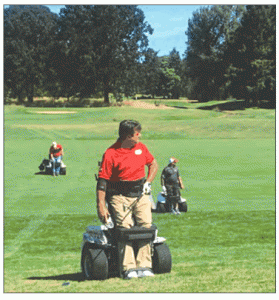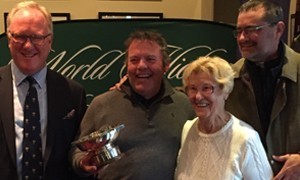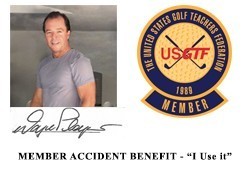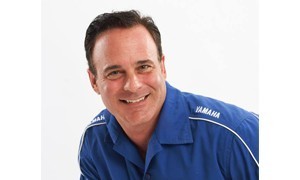Blog
Insurance Offered to all Members
“PRO” File – Touring Professional Pat Perez
Special Event and Workshop Available to USGTF Members
United States Disabled Open to be Held in May
History, Heritage And Preservation Of American Golf
By Mi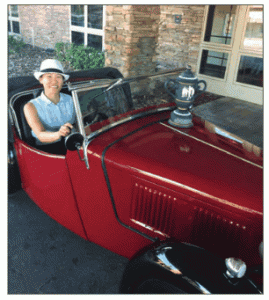 ke Stevens USGTF Certified Golf Teaching Professional, Tampa, Florida
ke Stevens USGTF Certified Golf Teaching Professional, Tampa, Florida
Bobby Jones once said the finest golf swing he ever saw belonged to Joyce Wethered. There were some exceptional female golfers in the early 1900s, once they were allowed on the courses from which they were previously excluded.
Playing with hickory-shafted clubs, they added considerable style and grace to the gentlemen’s game. Some of the early pioneers were Dorothy Campbell, the first woman to win the British, Canadian and American amateur championships; Glenna Collett Vare, who dominated women’s golf in 1920, and the famous Curtis sisters (Margaret and Harriot), Beatrix Hoyt, Lady Margaret Scott and Alexa Stirling, who toured the country with Jones giving golf exhibitions. All these wonderful players had one thing in common: They had beautiful swings and played the game with hickory-shafted golf clubs.
The United States Professional Hickory Golf Championship, which was originated in 2011, has always been open to both male and female golf professionals. It is played at Temple Terrace Golf & Country Club, opened in 1922, just north of Tampa, Florida. The first six contests have been dominated by the guys, but the 2017 and seventh was a different story. For several years, the U.S. Open was dominated by British golfers until American players gained their footing. I guess it just took a little time for the gals to get theirs, as Orlando’s Ki Shui Liao navigated the demanding Temple Terrace Golf & Country Club this past February in 75 strokes to become the Champion American Professional Hickory Golfer of the Year. She secured a spot on the John Shippen Trophy, which is dedicated to America’s first golf pro. Shippen played in the 1896 U.S. Open at Shinnecock Hills, where he also worked under Scotsman Willie Dunn Jr.
In those days, the U.S. Open and the U.S. Amateur were played during the same week on the same course. So, in keeping with that spirit, the United Stated Amateur Hickory Golf Championship is also a part of the day’s historical celebration. Bill Geisler of Winter Park, Florida, edged out two-time champion Will Peterson of Orlando by a single shot. Geisler’s name will be affixed to the Oscar Bunn Trophy, celebrating the Shinnecock Indian who also played in the 1896 U.S. Open. Bunn began as a caddie at Shinnecock and learned to play under the tutelage of Dunn.
Ninety-two years ago, the best professionals in the land gathered at Temple Terrace to compete in the Florida Open. It was one of the last tournaments where all players used clubs made of hickory and persimmon wood. The purse was $5,000. Jim Barnes was the host pro who welcomed the likes of Walter Hagen, Gene Sarazen and eventual winner Leo Diegel. The U.S. Professional Hickory Championship of this day is a tribute to those great golfers often forgotten over time. The amateur portion of the day recalls the likes of Bobby Jones, Harold Hilton, John Ball and Walter Travis. Having the ladies included just adds a bit of class and elegance to this remembrance of American golf as it began all those years ago.
Do Not Dummy Down
By James E. “Coach” Robertson, USGTF Contributing Writer – Magnolia, Arkansas
Time and time again I hear from coaches and players, “You need to ‘dummy down’ your in-formation for us!” My immediate reaction is, “No, you need to smarten up!
One of my mentors use to say “always look for simplicity on the other side of complexity,” meaning that as coaches, we must understand the complexity of the issue or technique and then find the simplicity in training the golfer for competitive play.
From my perspective, coaching is not about “dummying down” information or techniques. It is about starting with basics at a level each player can understand, and more importantly implement, and helping those golfers advance the technique or information as their competitive skills progressed.
One example of this process is with pre-shot routines. Here is the note I sent recently to a high school golf coach – whom I am pleased to say was one of my collegiate golfers:
IMPLEMENTATION STRATEGY Utilize the following training sequence for new golfers, most high school golfers, and in reviewing each collegiate golfer’s current routine. I have actually employed this technique with a few of our professional golfers to help them get their routines back on track when the wheels start to fall off during competitive play.
READY, AIM, FIRE Start with teaching a very basic “Ready, Aim, Fire” shot routine to golfers, and then expand the techniques within each player’s routine as they progress in competitive play.
During competitive play, watch and ensure that each player is working through the basic “Ready, Aim, Fire” sequence, versus the normal “Fire, Ready…woops, I forgot to Aim” sequence they normally revert to under pressure.
THE BASICS (this can be your initial coaching lesson with each golfer) Ready: From a position behind the ball (it is important to work from behind the ball and with both eyes on the target), select a specific target to play to.
– Remain mindful of your target through your entire routine. – While still behind the ball, take one or two practice (rehearsal) strokes. It is important to develop a sense of success with each swing.
Aim: As you move into your setup, aim the clubface down the target line at your target. (Some players will be playing a draw or fade, and thus their target line will be to the right or left of the target, but the key is to coach them on setting the clubface so that it is aiming down the appropriate target line.)
Next, align your body; position it correctly for the shot. This includes working into a position that allows you to remain balanced through the shot. Balance is the key.
Fire: Aim, move into your stance, and fire. Avoid “freezing” over the ball. Pose for your photo! Hold your finish for at least two seconds, smile, and pose for your photo…on every shot!
START Start your training and coaching with putting, and advance the techniques of each golfer as their competitive use of the technique improves.
KEEP MECHANICS IN THEIR PLACE You undoubtedly noticed that I made no mention of stroke mechanics in the basics for the routine. While effective setup and stroke mechanics are essential with all shots, mechanics by themselves will not ensure more successful shots.
It is important to habituate effective setup and stroke mechanics and be able to employ them automatically within your routine.
COACHING The beauty in this process for coaching is that while you can only guess at the mental and emotional processing the golfer is doing, you can now check, coach, and guide each golfer’s behavior, which will give you insight into their mental/emotional states.
You can observe and assess each player’s execution of their routine effectively during competition/play. Answer “yes” or “no” to the following questions:
Ready. – Is the player working from behind the ball correctly? – Do they appear to you to be physically poised (versus rigid) in their setup? – Do they appear mentally engaged (versus scattered thinking) in their setup?
Aim. – Does the golfer visually align with their target from a position behind the ball? – Are they aiming the clubface down the target line? – Are they aligning their body correctly in relationship with the target line? (Make sure you know their normal stance: slightly open, closed, etc.)
Fire. -Is their body flowing from the setup into, and through, the swing (no freezing over the ball)? – Do they appear to be properly balanced in their setup and remain in balance through their finish? – Does their swing appear to “flow” naturally? – Are they swinging through to their finish and not simply down to the ball? – Are they holding their finish for at least two seconds and smiling?
FINAL NOTE In preparing for competitive play, make certain practice holes “routine holes,” meaning that on those three or four holes, each player focuses exclusively on their routine, nothing else. I actually have a score sheet designed where each player records their effectiveness score on the use of their routine.
I would wish all coaches and players good luck, but we all know that we make our own luck!
– Coach
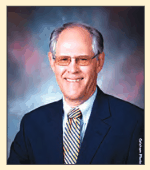 Coach Robertson has been a Tour instructor since the 1980s. He is a staff writer for the World Golf Teachers Federation, a former head college golf coach in North Carolina, Oregon and Arkansas, and a performance consultant to several collegiate and professional golfers. Author of The GOLF Team Swing & Performance Manual and The Encyclopedia of Successful GOLF Coaching. Coach always enjoys your feedback and can be contacted at (870) 949-9010, CoachRobertson01@Suddenlink.net, or on Skype at james.e.robertson
Coach Robertson has been a Tour instructor since the 1980s. He is a staff writer for the World Golf Teachers Federation, a former head college golf coach in North Carolina, Oregon and Arkansas, and a performance consultant to several collegiate and professional golfers. Author of The GOLF Team Swing & Performance Manual and The Encyclopedia of Successful GOLF Coaching. Coach always enjoys your feedback and can be contacted at (870) 949-9010, CoachRobertson01@Suddenlink.net, or on Skype at james.e.robertson
Training Aids Are Only Good When They Are Used
I just got back from the World Golf Teachers Cup gathering in Las Vegas. On the driving range, we were treated to demonstrations of several training aids. Some to increase swing speed, some to improve impact position and some to improve the overall swing motion. Over the years, I have used or recommended certain training aids to students based on their specific needs. I believe there is value in using them if one is committed to getting better. The key word is committed. That takes effort, and effort is not easy because it takes time. No truer words than “Rome was not built in a day” can be applied to learning golf techniques. It takes time and commitment.
One of the problems I see when aids are advertised on TV is that they would have one believe that there is almost instant success. Often, I see a fellow working with a training aid, and then maybe a few weeks later, there he is on the range without it. When I ask why he is not using the aid, often the reply is, “It didn’t work.”
Unfortunately, we live in a world where people want instant gratification, the worst thing when it comes to learning golf. That is why I emphasize in all my lessons that getting good at golf is a long-term process that takes patience, commitment and effort. When I recommend a training aid, I let the student know that using it will help ingrain good habits over time, and those habits will stay in place with continued use.
Teaching in A Simulator Vs. Teaching Outdoors
 In addition to my duties as national course director for the USGTF, I also teach at two facilities near where I live, one outdoors at a golf course and another in an indoor simulator at a major golf store. The latter is a recent addition to my teaching, and it has been extremely illuminating seeing the contrasts to teaching on an outdoor range. If you’ve been teaching with a simulator or with a launch monitor like TrackMan or FlightScope, some of what I’m about to write won’t come as any great surprise to you. Still, it’s been interesting to see how people learn and perform in the different environments.
In addition to my duties as national course director for the USGTF, I also teach at two facilities near where I live, one outdoors at a golf course and another in an indoor simulator at a major golf store. The latter is a recent addition to my teaching, and it has been extremely illuminating seeing the contrasts to teaching on an outdoor range. If you’ve been teaching with a simulator or with a launch monitor like TrackMan or FlightScope, some of what I’m about to write won’t come as any great surprise to you. Still, it’s been interesting to see how people learn and perform in the different environments.
 The third thing I learned, even though I already knew this but not to the degree I know now, is that a ball that starts well right of the tar-get line can be produced by a swing path that is well to the left, and vice versa. When I see a ball that starts well to the right outdoors and curves even farther right, I simply cannot tell with any degree of reasonable certainty what the clubhead path did, especially if the shot came from a driver off the tee. With an iron shot, at least we have a divot that can give us a clue, but one that is often not 100 percent reliable. So having accurate club-head path data is a real benefit to the teacher.
Finally, I have learned that many male golfers have a serious case of too-flat lie angles at impact, some regularly hitting shots with toe angles at 7° downwards! I have access to some clubfitting equipment featuring iron lie angles 3° upright from standard, but even with these, it’s not nearly enough to get some golfers to have flat lie angles at impact. Of course the problem is in their swings, but there’s only so much you can do during the course of one lesson.
The other feature we have in the indoor simulator is two simultaneous working cameras, one for the face-on view and one for the target-line view. The video software allows me to draw the usual lines, circles, etc., and compare a student’s swing to dozens of touring pros’. With few exceptions, students’ swings change perceptibly during the course of one lesson, and I’m able to email the students their before and after comparisons.
I want to be clear: It’s still possible to teach very effectively outdoors with no technology (See “No TrackMan? No Problem,” Winter 2017 edition, Golf Teaching Pro). Even with all my hi-tech tools in the simulator, I find myself working mainly on the same basic fundamentals with students that I would outdoors. But I would be less than honest if I said having some advanced technology wasn’t a great help, and it’s helped me learn some things that have improved my abilities as a teacher.
As golf technology becomes less expensive and more available, I believe it’s only a matter of time before the vast majority of teachers will rely on some form to aid in their instruction programs. But without a competent teacher schooled in the art and science of golf instruction, these gadgets are virtually worthless, and in fact could prove detrimental to the golfer who doesn’t understand what’s important and what’s not. There will al-ways be a place for knowledgeable golf teaching professionals, regardless how much teaching technology may advance.
The third thing I learned, even though I already knew this but not to the degree I know now, is that a ball that starts well right of the tar-get line can be produced by a swing path that is well to the left, and vice versa. When I see a ball that starts well to the right outdoors and curves even farther right, I simply cannot tell with any degree of reasonable certainty what the clubhead path did, especially if the shot came from a driver off the tee. With an iron shot, at least we have a divot that can give us a clue, but one that is often not 100 percent reliable. So having accurate club-head path data is a real benefit to the teacher.
Finally, I have learned that many male golfers have a serious case of too-flat lie angles at impact, some regularly hitting shots with toe angles at 7° downwards! I have access to some clubfitting equipment featuring iron lie angles 3° upright from standard, but even with these, it’s not nearly enough to get some golfers to have flat lie angles at impact. Of course the problem is in their swings, but there’s only so much you can do during the course of one lesson.
The other feature we have in the indoor simulator is two simultaneous working cameras, one for the face-on view and one for the target-line view. The video software allows me to draw the usual lines, circles, etc., and compare a student’s swing to dozens of touring pros’. With few exceptions, students’ swings change perceptibly during the course of one lesson, and I’m able to email the students their before and after comparisons.
I want to be clear: It’s still possible to teach very effectively outdoors with no technology (See “No TrackMan? No Problem,” Winter 2017 edition, Golf Teaching Pro). Even with all my hi-tech tools in the simulator, I find myself working mainly on the same basic fundamentals with students that I would outdoors. But I would be less than honest if I said having some advanced technology wasn’t a great help, and it’s helped me learn some things that have improved my abilities as a teacher.
As golf technology becomes less expensive and more available, I believe it’s only a matter of time before the vast majority of teachers will rely on some form to aid in their instruction programs. But without a competent teacher schooled in the art and science of golf instruction, these gadgets are virtually worthless, and in fact could prove detrimental to the golfer who doesn’t understand what’s important and what’s not. There will al-ways be a place for knowledgeable golf teaching professionals, regardless how much teaching technology may advance.
Anthony Netto Stands Up And Plays
USGTF 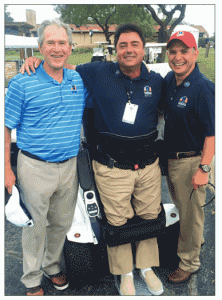 member Anthony Netto lives a more active life than most people, even though he cannot walk, much less run. Netto was on his way to play in a professional golf tournament in his native South Africa in 1994 when his car was hit by a drunk driver, leaving Netto paralyzed from the waist down. And all of this happened just several months after attending a USGTF certification course in the United States.
member Anthony Netto lives a more active life than most people, even though he cannot walk, much less run. Netto was on his way to play in a professional golf tournament in his native South Africa in 1994 when his car was hit by a drunk driver, leaving Netto paralyzed from the waist down. And all of this happened just several months after attending a USGTF certification course in the United States.
Netto was a first lieutenant in the South African army and was a veteran of Desert Storm in the early 1990s. After his discharge, he returned to golf and earned his USGTF certification. But the accident put his plans on hold. It is understand-able if Netto felt the normal reactions after such a horrific accident of despair and anger, but if he did, he quickly put them aside and went to work. Attempting to return to the game of golf in a traditional wheelchair, Netto found it too restraining and difficult to play the game in a proper way. He set about inventing a device that would allow him to basically stand while playing, just like able-bodied golfers. Thus, the Paragolfer came about, which rides like a normal wheelchair with the exception that the seat and seatback lift up and puts a person in a standing position.
The Paragolfer was later renamed the Para- mobile because it can be used for more than just golf. Sports like shooting, archery, hunting and fishing are made easier for people from the Para-mobile.
As the Paramobile puts less pressure per square inch on the ground as compared to a normal foot-print, the device lends itself well to golf and doesn’t damage the golf course, including the greens. Under the Americans with Disabilities Act, the Paramobile is welcome at facilities all across the country.
Netto travels the United States these days, promoting the Paramobile and seeking funding for those in need to buy them through his Stand Up And Play Foundation. Manufactured by the German company Ottobock, the Paramobile is available for a purchase price of $22,500.
The Invictus Games, which brings together veterans from 17 countries who compete in adaptive sports, will feature golf for the first time in 2017 in Toronto, Canada. Netto is proud that the Paramobile will be used in order to allow some of the golfers to compete.
Netto has also met former U.S. presidents George W. Bush and Barack Obama, the latter while he was still in office. Obama, an avid golfer himself, took an interest in Netto and the Para- mobile.
In regard to Bush, Netto met him several years ago at the 4th annual Warrior Open, where Netto smashed a drive 270 yards down the middle of the fairway. He still drives the ball farther and plays the game better than most able-bodied golfers, a testament to his grit and determination.
Netto is currently based out of Las Vegas, Nevada, and travels to support and promote the Stand Up And Play Foundation. The fundraising road has been a difficult one, but Netto has succeeded in getting a number of Paramobiles into circulation for use by those who are paralyzed.


